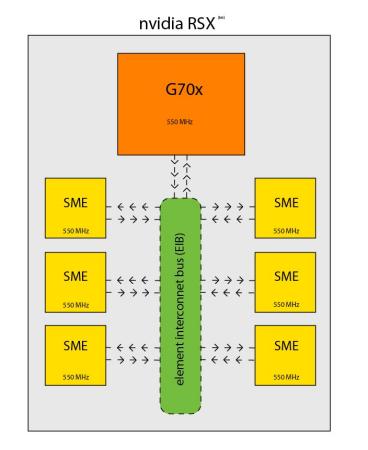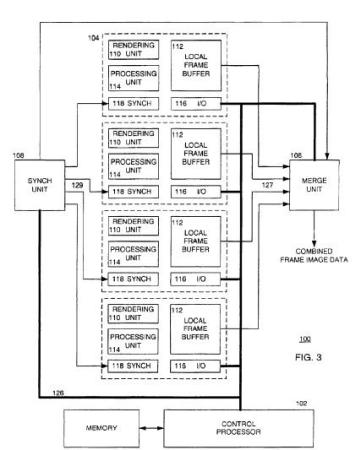coraz więcej rzeczy wskazuje na to, iż Sony pracuje nad systemem online do PS3. Konkurencja dla Live? Raczej mało prawdopodobne, ale kto wie. Może w następnej generacji

:
http://ps3.qj.net/2006/01/psm-article-informs-of-sonys-online.html#commentsEDIT: no i jeszcze takie "ciekawostki" o RSX'ie (info znalazłem na PLAYSTATION boards w dziale Killzone- pierwsze pochodzi z jakiejś Chińskiej strony).
1. RSX in certain aspect taken the design concept of CELL. It has ditched linear processing format of traditional GPUs. In Cell, PPE is resposible for control the overall workflow, but in RSX, they chose to use a customized G70 central core. It taken pure video, ultra shadow2, and cineFX, etc out of the normal G70.
In CELL, PPE can control SPEs. in RSX, the customized G70 can control up to 4-6 specialized multifunction, multithreaded programmable cores.

The SME in the diagram above are media processing incrementation units. It can process vertex, shadow, lighting (direct and indirect lighting), over shadow calculation. And G70x will process AA, after rendered effects and motion blur.

Raczej jest to niemożliwe (zbyt duże koszty) choć Xenos ma coś na wzór 2 rdzeni. Pozatym nie były by to "pełnoprawne" rdzenie (podobnie jak w Cell'u). Choć RSX miał bazować na G71 (różnica jest tylko w technologi wytwarzania).
2. "The special characteristic of the PS3 is the connection between Cell and RSX
The big special characteristic of PS3 Graphics is the connection between Cell and RSX. The RSX itself has a similar architecture to the G70, but the host interface for the G70 is meant for the PC and is completely different. The G70 uses PCI Express x16 to connect to the chipset as 8GB/sec (4GB/sec one-way), and it cannot directly access main memory. In contrast, the RSX has a 35GB/sec (20GB/sec down, 15GB/sec up) direct connection to the Cell, and can directly render from the main memory on the Cell side.
This is a big difference, because it allows a completely different way of using the GPU from PC architectures, SCEI explained. First of all, because the bus is wider, the Cell can perform a great amount of geometry operations, then send the vertex data [to the RSX]. Conversely, the RSX side can easily send data back to the Cell.
“The Cell processor can do both pre-processing and post-processing. For example, tessellation, dot filling, etc… Cell can perform physics processing like collision and motion calculations, and transform the vertex array.” said David B. Kirk, Chief Scientist of nVidia.
SCEI basically expects higher abstraction levels to be processed by Cell, and the details (like vertexes and pixels) to be processed by the GPU. The is reasonable – for example, in the case where the CPU side handles geometry transformation, collision detection, which is important in games, is not a problem. In the case where the GPU handles geometry transformation, if the data is not sent back to the CPU, clipping issues may occur. In the case of the PS3, the Cell side can perform transformations, and even if the GPU is used for transformation, it is comparatively easy to send the data back to the CPU side.
In architectures up to now, either the CPU or the GPU have been the bottleneck. It this is not resolved, we cannot go any further. To face this, in PS3 architecture, if the GPU becomes the bottleneck, it can shift work to the Cell, if the Cell becomes the bottleneck it can send work to the GPU, shifting the workload. For example, according to the software, the Cell side can perform more graphics processing, or, oppositely, or easily make an adjustment to leave the graphics work to the GPU, it was explained. In summary, between the CPU and GPU programmable processors, a flexible balance adjustment can be done.
In previous PC architectures, because they were limited by the CPU<->GPU pipe, geometry operations were held to a certain limit, and how rich an environment you can create within that limit became the main technical challenge. In contrast, the PlayStation2-type game consoles created large amounts of polygons, but after that it did not have the expressiveness of PCs. (Trans. note: probably means that PS2 is less capable in applying different effects to polygons than the PC, despite pumping out more polygons.) In the case of the PS3, both are possible, with the flexibility to balance the two.
However, in the case of the currently available PS3 Evaluation System, because of restrictions in the architecture, it is not possible to evaluate the balancing [of Cell and RSX]. This is a difficulty and a weakness, but, if we state it differently, software demos on the current systems still do not demonstrate the full potential of PS3. It is possible that the actual PS3 will have performance greater than current demos."
Należy to raczej traktować z przymrużeniem oka.